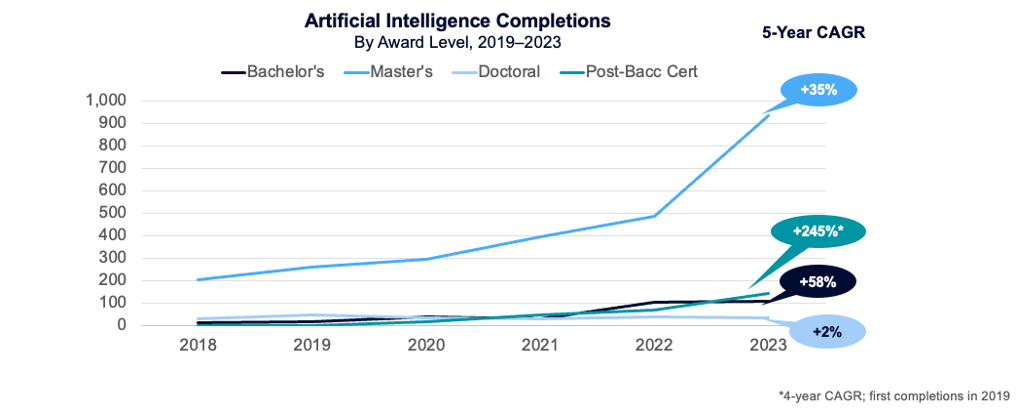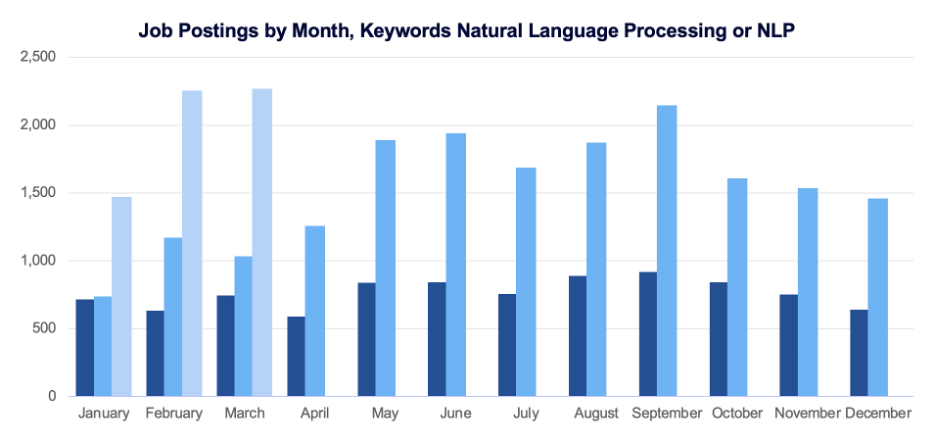Artificial Intelligence (AI) is no longer a futuristic concept; it’s a rapidly evolving field shaping industries across the globe. And as the demand for AI professionals skyrockets, so does the demand for AI education. Recent data reveals a fascinating landscape of growth and diversification in AI programs, with master’s degrees leading the charge and community colleges stepping up to meet the growing need for skilled workers.
Master’s Degrees: The Dominant Force

Source: Gray DI’s Program Evaluation System (PES) Markets
The data paints a clear picture: Master’s degrees in AI are the most popular award level for AI programs. Completions at the master’s level have seen an impressive average annual growth rate (CAGR) of 35 percent from 2018 to 2023. This dominance is further reinforced by the surge in new fall enrollments, which have grown by 56 percent annually from 2019 to 2024, with the lion’s share occurring at the master’s level.
This trend is also reflected in online search behavior, with keyword searches heavily concentrated on master’s programs, reaching a volume of 94,700 searches in February 2025 alone, a 33 percent year-over-year increase.
While post-baccalaureate certificates and bachelor’s degrees have also experienced significant growth (245 percent and 58 percent, respectively), it’s important to note that they started from a very small base in 2019. On the other hand, doctorate-level completions have seen the least growth, even experiencing a dip in the last year.
Community Colleges: Democratizing AI Education
The AI education boom isn’t limited to traditional four-year universities. Community colleges are crucial in expanding access to AI training and preparing students for in-demand roles. This development is essential for bridging the skills gap and ensuring a diverse workforce in the AI sector.
According to this January 2025 article, North Carolina’s 58 community colleges are developing programs, pathways, and degrees in AI. The Maricopa Community College District has established programs across its campuses. Central Piedmont Community College now offers an Associate of Applied Science in AI, focusing on critical skills like generative AI, chatbots, and machine learning. Alamance Community College is set to launch a similar Associate of Applied Science in AI in spring 2025.
These programs offer accessible and affordable pathways to AI careers, equipping students with practical skills immediately applicable in the workplace.
Employer Demand: A Clear Signal
The surge in AI education is driven by strong employer demand. Job postings mentioning “Natural Language Processing” (NLP) more than doubled in March 2025 compared to the previous year, reflecting the growing importance of this technology.

Source: Gray DI’s Program Evaluation System (PES) Job Postings Insights: Description Search
The Information Technology industry leads the pack in AI job postings, followed closely by Retail and Wholesale. Interestingly, Financial Services also demonstrates a significant demand for AI professionals, exceeding that of healthcare professionals. This underscores the broad applicability of AI across diverse industries.
What This Means for the Future
The data convincingly indicates a rapidly growing demand for AI programs. The dominance of master’s degrees signifies the growing need for advanced AI expertise. The entry of community colleges democratizes AI education, making it accessible to a broader audience. Strong employer demand emphasizes the importance of investing in AI skills development.
As AI transforms industries, the demand for skilled professionals will only increase. Educational institutions must continue to adapt and innovate to meet this demand, ensuring a future workforce equipped with the knowledge and skills necessary to thrive in the age of AI.




